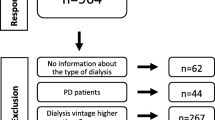Abstract
The choice of dialysis treatment, as well as of the type of centre in which to receive it, can be the result of a selection process where perceived quality, and the reputation of medical centres and physicians, as well as other observable and unobservable factors play a key role. ESRD patients can choose among alternative treatments, namely HD, HDF and PD. While HD and HDF can be received at public hospitals and private centres, with no difference between the two options in terms of assistance provided, PD is mainly carried out at home.
This paper considers the possibility of adopting different econometric techniques to model such simultaneous patients' choice by the patients. After having examined conditional logit models and a multinomial logit framework that might suit our purposes, we selected a recursive bivariate probit model. The analysis tools presented in this paper proved to be appropriate in this context and succeeded in identifying a link between the selection of HD as a dialysis modality with patients' characteristics, and type of dialysis centre.
Similar content being viewed by others
References
Alloatti, S., Manes, M., Paternoster, G., Gaiter, A.M., Molino, A., Rosati, C.: Peritoneal dialysis compared with haemodialysis in the treatment of end stage renal disease. Journal of Nephrology 13, 331–342 (2000).
Benitez-Silva, H., Buchinsky, M., Chan, H., Cheidvasser, S., Rust, J.: How large is the bias in self reported disability? Journal of Applied Econometrics (2003).
Cogny-Van Weydevelt, F., Bacquaert-Dufour, K., Benevent, D.: A cost-effectiveness analysis of capd vs. selfcare in center haemodialysis in france. Dialysis and Transplantation 28, 70–74 (1999).
Fabbri, D., Monfardini, C., Radice, R.: Testing exogeneity in the bivariate probit model: Monte Carlo evidence and an application to health economics. Working Paper, Department of Economics, University of Bologna (2004).
Frondel, M., Horbach., J., Rennings, K.: What triggers environmental management and innovation?. RWI Discussion Paper, 15 (2004).
Gitto, L.: Un problema di allocazione efficiente in sanità: la scelta tra metodiche alternative di dialisi. Politiche Sanitarie 1, (2005).
Greene, W.H.: Gender economics courses in liberal arts colleges: further results. Journal of Economic Education Fall 291–300 (1998).
Greene, W.H.: Econometric analysis 3rd edition, Macmillian Publishing Company (1997).
Hausman, J., McFadden, D.: A specification test for the multinomial logit model. Econometrica 5, 1219–1240 (1984).
Heckman, J.: Dummy endogenous variables in a simultaneous equation system. Econometrica 46, 931–959 (1978).
Held, P.J., Pauly, M.V.: Competition and efficiency in end stage renal disease program. Journal of Health Economics 2, 95–118 (1983).
Holly, A., Gardiol, L., Domenighetti, G., Bisig, B.: An econometric model of health care utilization and health insurance in switzerland. European Economic Review 42, 513–522 (1998).
Iliffe, S.: Healthy choices. Health Matters http://www.sochealth.co.uk/news/patientschoice.htm (2003).
Jones, A.M.: Applied econometrics for health economists. a practical guide department of economics and related studies. University of York (2001).
Kendix, M.: Dialysis modality selection among patients attending freestanding dialysis facilitites. Health Care Financing Review Summer (1997).
Maddala, G.S.: Limited Dependent and Qualitative Variables in Econometrics. Cambridge University Press, Cambridge (1983).
Mazzanti, M.: Discrete choice models and valuation experiments. An application to cultural heritage. Working Paper of the Società Italiana di Economia Pubblica (Italian Society of Public Economics) (2001).
Piccoli, G.B., Calderoni, M., Bechis, F., Iadarola, A.M.: Modelling the ideal self care—limited care dialysis centre. Journal of Nephrology 14, 162–168 (2001).
Schneider, H., Blaauw, D., Magongo, B., Kumalo, I., Palmer, N.: Patient choice of primary health care provider and the need to influence quality of care in the private sector. South African Health Review 7, 83–94 (1999).
Sisca, S., Pizzarelli, F.: Cost-benefit analysis and choice of dialysis treatment in Italy. Dialysis and Transplantation 3, 382–387 (2002).
Terza, J.: Alcohol abuse and employment: a second look. Working Paper of the Pennsylvania State University (2001).
Author information
Authors and Affiliations
Corresponding author
Additional information
JEL Classification I11, C35, C53
Rights and permissions
About this article
Cite this article
Gitto, L. Dialysis modality selection according to the medical care provided at dialysis units: An econometric analysis. Health Serv Outcomes Res Method 5, 227–241 (2004). https://doi.org/10.1007/s10742-006-6830-3
Received:
Revised:
Accepted:
Issue Date:
DOI: https://doi.org/10.1007/s10742-006-6830-3




